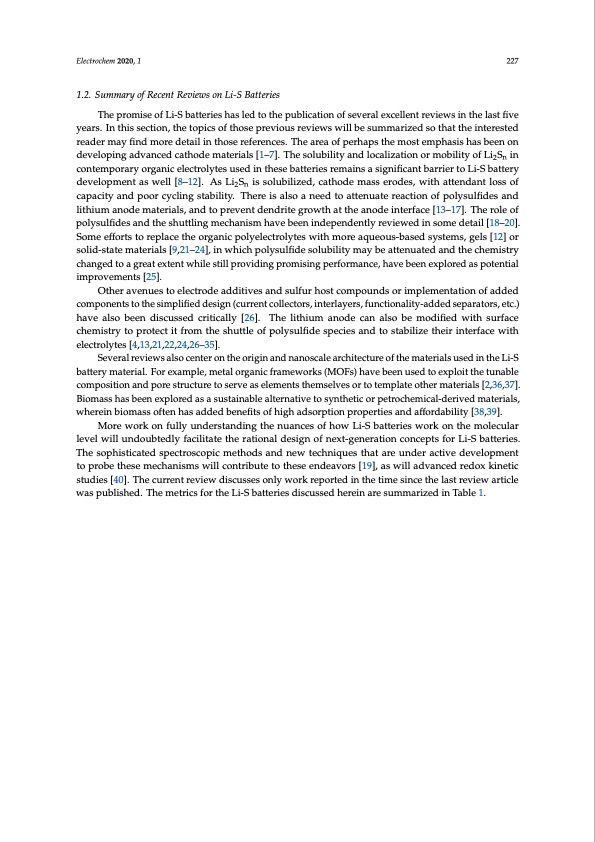
PDF Publication Title:
Text from PDF Page: 002
Electrochem 2020, 1 227 1.2. Summary of Recent Reviews on Li-S Batteries The promise of Li-S batteries has led to the publication of several excellent reviews in the last five years. In this section, the topics of those previous reviews will be summarized so that the interested reader may find more detail in those references. The area of perhaps the most emphasis has been on developing advanced cathode materials [1–7]. The solubility and localization or mobility of Li2Sn in contemporary organic electrolytes used in these batteries remains a significant barrier to Li-S battery development as well [8–12]. As Li2Sn is solubilized, cathode mass erodes, with attendant loss of capacity and poor cycling stability. There is also a need to attenuate reaction of polysulfides and lithium anode materials, and to prevent dendrite growth at the anode interface [13–17]. The role of polysulfides and the shuttling mechanism have been independently reviewed in some detail [18–20]. Some efforts to replace the organic polyelectrolytes with more aqueous-based systems, gels [12] or solid-state materials [9,21–24], in which polysulfide solubility may be attenuated and the chemistry changed to a great extent while still providing promising performance, have been explored as potential improvements [25]. Other avenues to electrode additives and sulfur host compounds or implementation of added components to the simplified design (current collectors, interlayers, functionality-added separators, etc.) have also been discussed critically [26]. The lithium anode can also be modified with surface chemistry to protect it from the shuttle of polysulfide species and to stabilize their interface with electrolytes [4,13,21,22,24,26–35]. Several reviews also center on the origin and nanoscale architecture of the materials used in the Li-S battery material. For example, metal organic frameworks (MOFs) have been used to exploit the tunable composition and pore structure to serve as elements themselves or to template other materials [2,36,37]. Biomass has been explored as a sustainable alternative to synthetic or petrochemical-derived materials, wherein biomass often has added benefits of high adsorption properties and affordability [38,39]. More work on fully understanding the nuances of how Li-S batteries work on the molecular level will undoubtedly facilitate the rational design of next-generation concepts for Li-S batteries. The sophisticated spectroscopic methods and new techniques that are under active development to probe these mechanisms will contribute to these endeavors [19], as will advanced redox kinetic studies [40]. The current review discusses only work reported in the time since the last review article was published. The metrics for the Li-S batteries discussed herein are summarized in Table 1.PDF Image | Lithium-Sulfur Batteries: Advances and Trends

PDF Search Title:
Lithium-Sulfur Batteries: Advances and TrendsOriginal File Name Searched:
electrochem-01-00016.pdfDIY PDF Search: Google It | Yahoo | Bing
Sulfur Deposition on Carbon Nanofibers using Supercritical CO2 Sulfur Deposition on Carbon Nanofibers using Supercritical CO2. Gamma sulfur also known as mother of pearl sulfur and nacreous sulfur... More Info
CO2 Organic Rankine Cycle Experimenter Platform The supercritical CO2 phase change system is both a heat pump and organic rankine cycle which can be used for those purposes and as a supercritical extractor for advanced subcritical and supercritical extraction technology. Uses include producing nanoparticles, precious metal CO2 extraction, lithium battery recycling, and other applications... More Info
| CONTACT TEL: 608-238-6001 Email: greg@infinityturbine.com | RSS | AMP |